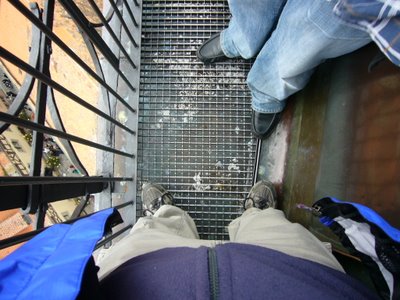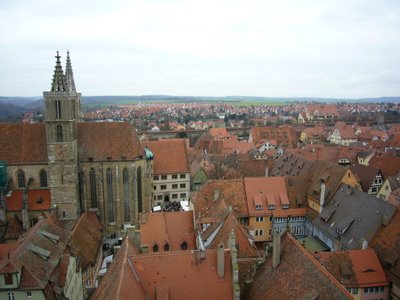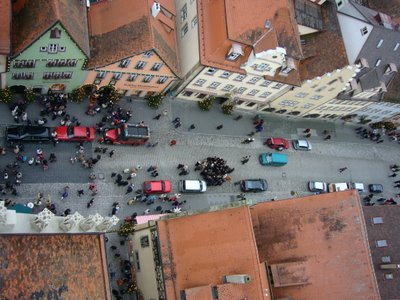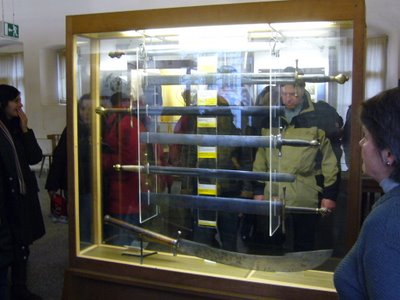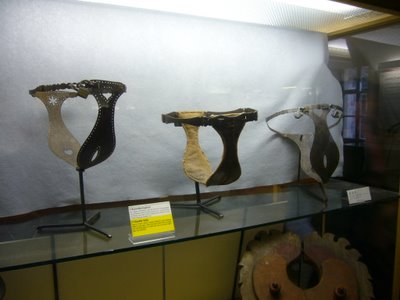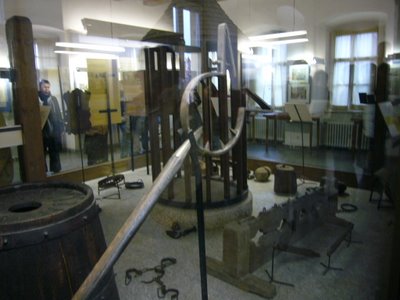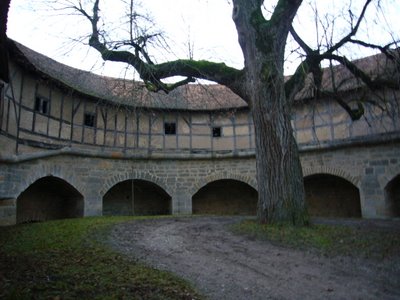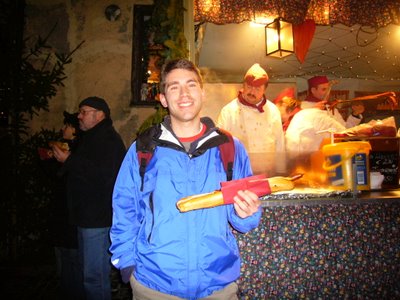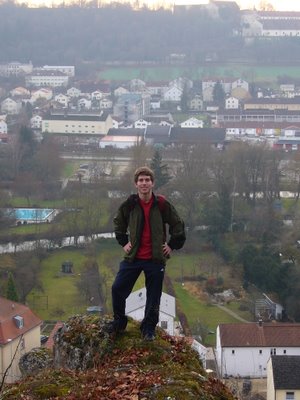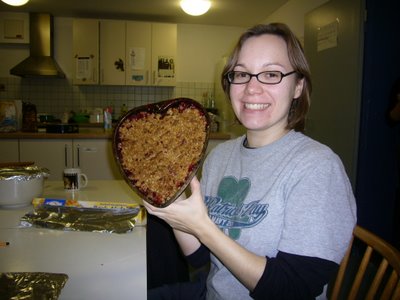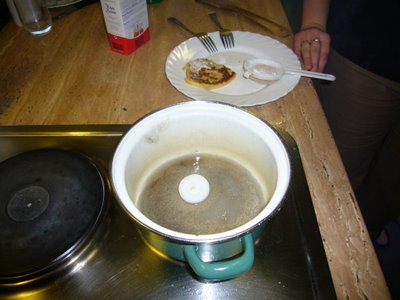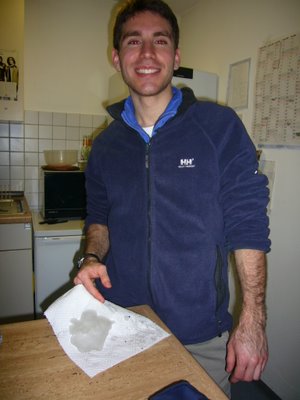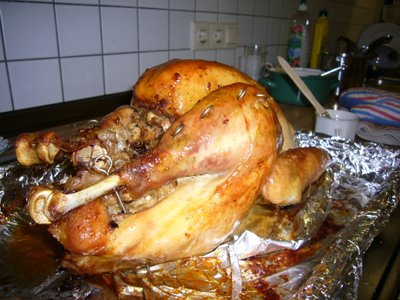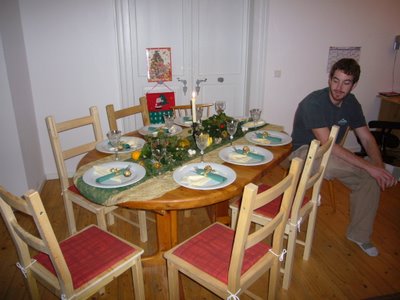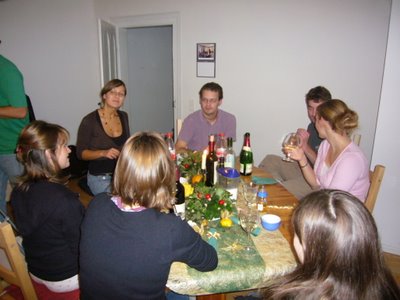Order of Celebration
Before my time here I would have said that Christmas was the 25th of December the world over, but that's not entirely so. Even in Germany there are some regional differences between the north and south ends of the country.
First off, there is more than one gift-bearing man associated with the season. St. Nikolaus visits homes on the night of December 6. Normally German childern will leave their shoes outside on this night and find candy, chocolate, and small gifts inside of them, placed there by St. Nikolaus of course, the next morning. Some say he comes with a donkey, and the childeren will also leave out some food, like carrots, for his quadruped friend. However, St. Nick also has colleagues who make their rounds on this night. Bad children receive "gifts" from Knechtruprecht. In the North he brings coal, in the South he brings switches. Sometimes an angel also accompanines St. Nikolaus and helps watch over the children and keep track of which ones have been good. Afterall, that's a tough job to do alone.
Then comes December 24, Heiliger Abend or Holy Eve, the most important day of celebration.
In the afternoon children receive their main round of gifts from another special fellow. In the North comes the Weihnachtsmann, that is the Christmas Man. Children in the South receive gifts from the Christkindmann, which one can translate to the Christ Child Man. It's the same man you see, simply a difference in names. He wears white robes, sometimes a miter hat, and carries a staff with his gift sack. In comparison, St. Nikolaus wears clothes similar to Santa Claus. In the north some say that the Weihnachtsmann comes with flying reindeer and lives at the North Pole, where he has some elves to assist him. However, the Kristkindmann lives in Heaven and gets help from angels.
On the afternoon of the 24th a parent will take the children out for a walk or somewhere else away from the house, and upon their return the Weihnachts/Christkindmann has visited.
The adults will also exchange their gifts on December 24th. There is usually a large dinner with family or friends.
Then on December 25th, Weihnacthen, Christmas. There is usually another large meal and visits with other family members on this day.
Oh Tannenbaum
The Christmas tree, as many other of the American Christmas traditions, comes from Germany. Families usually buy the tree 10 to 15 days before Christmas, but do not actually bring it into the home and/or decorate until December 23rd. People in the North refer to the evengreen as a Weihnachtsbaum. Those in the South call it a Christbaum. The translations are Christmas tree and Christ tree, respectively.
The decorations on the tree are very similar to ours in America. Originally, Germans clipped actual candles on the trees. However, since after 10 to 15 days a Christmas tree is essentially dry tender, electric lights are now used for the most part; although, the lights still look like candles. Loose or string silver and gold garland lays over the branches to sympolize angel hair. The ornaments consist of shiny balls, baked cookies in assorted shapes like a gingerbread man . . . ,

. . . figures made from staw, and mini nutcrackers.
 Treetoppers exist in the forms of angels, stars, or decorative cones.
Treetoppers exist in the forms of angels, stars, or decorative cones.
The Christmas Market
As you saw in Rothenberg, nearly any German town of reasonalbe size has an outdoor Christmas market from December 1st to the 23rd. Typical market vendors sell decorations, seasonal food and sweets, hand made products, and other goods. In the South the markets sometimes go by the name Christkindlmarkt.
Here are some views of the Eichstaett Christmas Market:

The most famous and largest Christmas Market is the one found in Nuremberg. The oldest record of the Nuremberg Christmas Market date to the mid-1600s. Today, more the two million people from around the world visit the market's hundred's of stalls every year. I had the fortune to visit the market last Wedneday with friends. You can see it here from a vantage point overlooking the market square.
The market is centered in the above photographed square in the city center of Nuremberg, but stalls overflow onto the streets radiating out from the square.
It was definitely a sight a see, and perhaps my favorite German experience yet. In this photo Mareike (German) and Olga look over some Christmas tree ornaments.

And some more photos from the market:
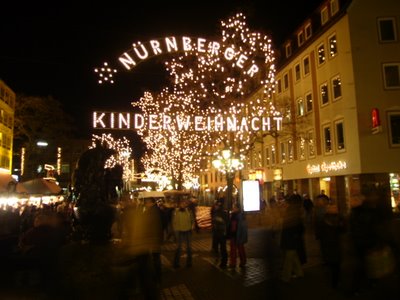



Here's a last one of the full group with, from left to right, Mareika, Olga, Sylvia (Hungar), Heidi (Germany), and me.

But the Christmas Market does not end your crash course in German christmas.
Food and Drink
As with any special holiday in any culture around the world, Germans cook and prepare special food items for the Christmas season.
There are a multitude of speciality baked items for Christmas, but two stand out the most: Stollen and Liebeküchen. Stollen is a type of cake usually flavored with nuts, raisins, and marzipan, and covered in powdered sugar. I may be mistaken, but I believe that it originates from Dresden. A photo of a Christmas Market vendor selling the cakes is below:
 Liebeküche are small sweets that resemble cookies but whose texture is more similar to a cake. They have a glazed sugar coating and are highly seasoned with nutmeg and cinnamon. They come from Nuremberg, and the translated name is "love cake."
Liebeküche are small sweets that resemble cookies but whose texture is more similar to a cake. They have a glazed sugar coating and are highly seasoned with nutmeg and cinnamon. They come from Nuremberg, and the translated name is "love cake."
There is also one drink that one is sure to find in bottles in stores or for sell by the cup around town during the Christmas season: Glühwein or "glow wine." Cinnamon, sugar, and other spices are added to a fruity wine, then the drink is warmed and served hot. I think it's one of those things that you either love or hate. I bought a bottle of it from the supermarket, warmed up a serving, and almost spit it out of my mouth with the first taste. In my opinion, it tasted like warm cough sryup. But I tried it again with extra sugar and cinnamon and it agreed with me much better. The Germans, obviously, love the stuff.
Incidentally, I do not see any apple cider or egg nog here, and I'm certainly missing both.
Other Decor
There is of course the typical nutcracker (which, in case you didn't, comes from Germany), but there are two other decoration items I'd like to share with you. The first is the Rauchenmann, or "smoking man." They are hallow wooden figures of men usually six inches or so tall. They have a whimsical look to them, and the man typically holds a piple. One can open a compartment on the bottom of the figures and insert a piece of lit incense. The smoke rises through the man and out through an opening in his mouth, thereby giving the impression that the man is smoking. They are very popular and range in price from a couple Euros to over 50.
The other is a an Advent calender. As you can see in the picture down below, it is usually a thin box with 24 tear-open doors, one for each day from December 1st to Christmas Eve. Behind each door lies a small piece of chocolate or candy. These too are commonly found in homes with or without children.

And with that, I believe the lesson has almost come to an end. The last item is, naturally, how to say merry Christmas in German. The German spelling is Fröliche Weihnachten, but perhaps the phonetic spelling would suit you better: "frew-licke vie-nawk-ten." Alright, maybe that's a simplified pronounciation, but it should suffice.
The Christmas break officially begins this Friday and lasts for two weeks. When we come back it will still be the first semester, which will not end until early February.
Last night was the "Glühwein Seminar," an annual Christmas party hosted by the geography department. A few Geography professors were present, but it was by no means tonned down because of their presence. In fact they served a critical purpose at the party because they had to sign our Schein. A Schein is basically a certificate of satisfactory completion that one usually receives from a university course in Germany. For each Glühwein we drank we received a stamp on our Schein, and when finished we were supposed to have the professors sign the paper. It was different for me to see professors and students together in the same party, but was nonetheless a fun time.
It's definitely Christmas time, but not quite the Christmas that I'm used to, and that by no means is a complaint. My family will arrive in Munich this Sunday and they'll stay for a week. After that I will do a little traveling of my own until classes start back. With this busy itinerary I can not say for certain when my next post will be, perhaps not for another two to three weeks. Rest assured that I will eventually post my family's visit and my travels. Enjoy the season.
Merry Christmas
Fröhliche Weihnachten
Happy New Year
Ein gutes neues Jahr








